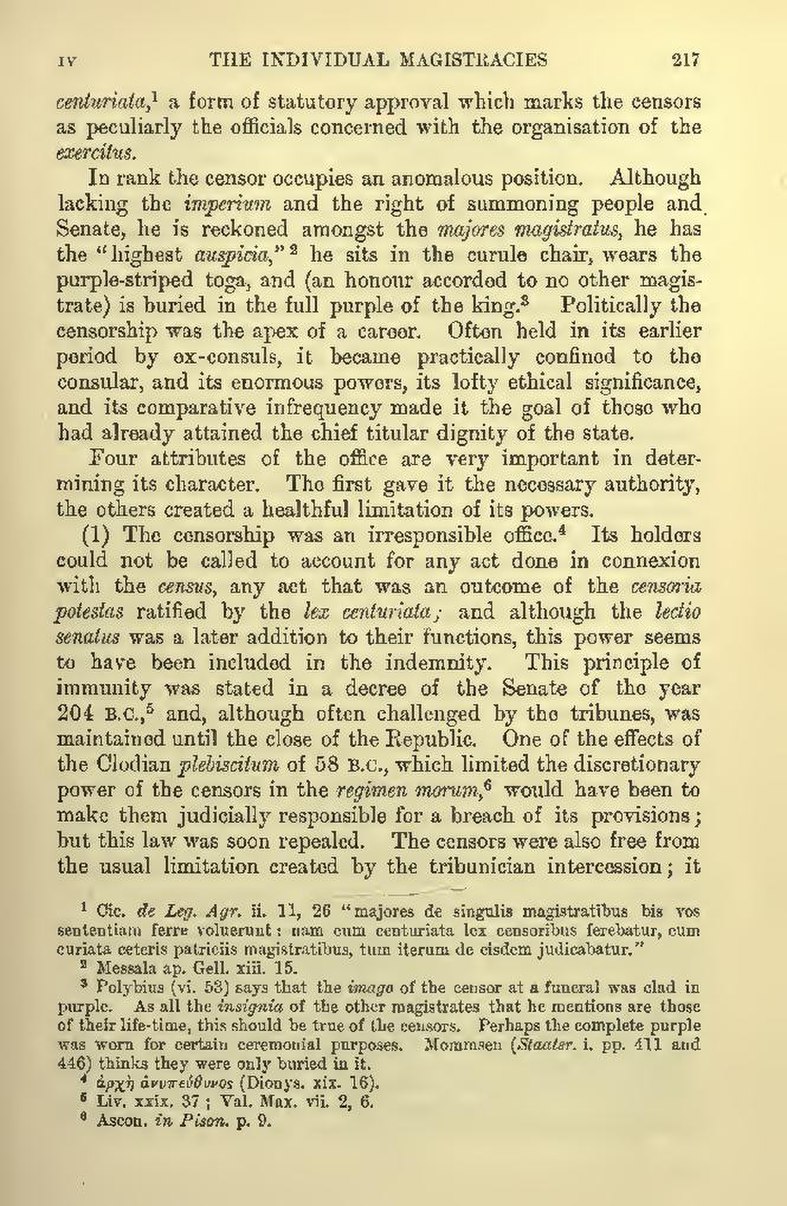centuriata,[1] a form of statutory approval which marks the censors as peculiarly the officials concerned with the organisation of the exercitus.
In rank the censor occupies an anomalous position. Although lacking the imperium and the right of summoning people and Senate, he is reckoned amongst the majores magistratus, he has the "highest auspicia,"[2] he sits in the curule chair, wears the purple-striped toga, and (an honour accorded to no other magistrate) is buried in the full purple of the king.[3] Politically the censorship was the apex of a career. Often held in its earlier period by ex-consuls, it became practically confined to the consular, and its enormous powers, its lofty ethical significance, and its comparative infrequency made it the goal of those who had already attained the chief titular dignity of the state.
Four attributes of the office are very important in determining its character. The first gave it the necessary authority, the others created a healthful limitation of its powers.
(1) The censorship was an irresponsible office.[4] Its holders could not be called to account for any act done in connexion with the census, any act that was an outcome of the censoria potestas ratified by the lex centuriata; and although the lectio senatus was a later addition to their functions, this power seems to have been included in the indemnity. This principle of immunity was stated in a decree of the Senate of the year 204 B.C.,[5] and, although often challenged by the tribunes, was maintained until the close of the Republic. One of the effects of the Clodian plebiscitum of 58 B.C., which limited the discretionary power of the censors in the regimen morum,[6] would have been to make them judicially responsible for a breach of its provisions; but this law was soon repealed. The censors were also free from the usual limitation created by the tribunician intercession; it(Dionys. xix. 16).]
- ↑ Cic. de Leg. Agr. ii 11, 26 "majores de singulis magistratibus bis vos sententiam ferre voluerunt: nam cum centuriata lex censoribus ferebatur, cum curiata ceteris patriciis magistratibus, tum iterum de eisdem judicabatur."
- ↑ Messala ap. Gell. xiii. 15.
- ↑ Polybius (vi. 53) says that the imago of the censor at a funeral was clad in purple. As all the insignia of the other magistrates that he mentions are those of their life-time, this should be true of the censors. Perhaps the complete purple was worn for certain ceremonial purposes. Mommsen (Staatsr. i. pp. 411 and 446) thinks they were only buried in it.
- ↑ [Greek: archê anypeuthunos
- ↑ Liv. xxix. 37; Val. Max. vii. 2, 6.
- ↑ Ascon. in Pison. p. 9.
